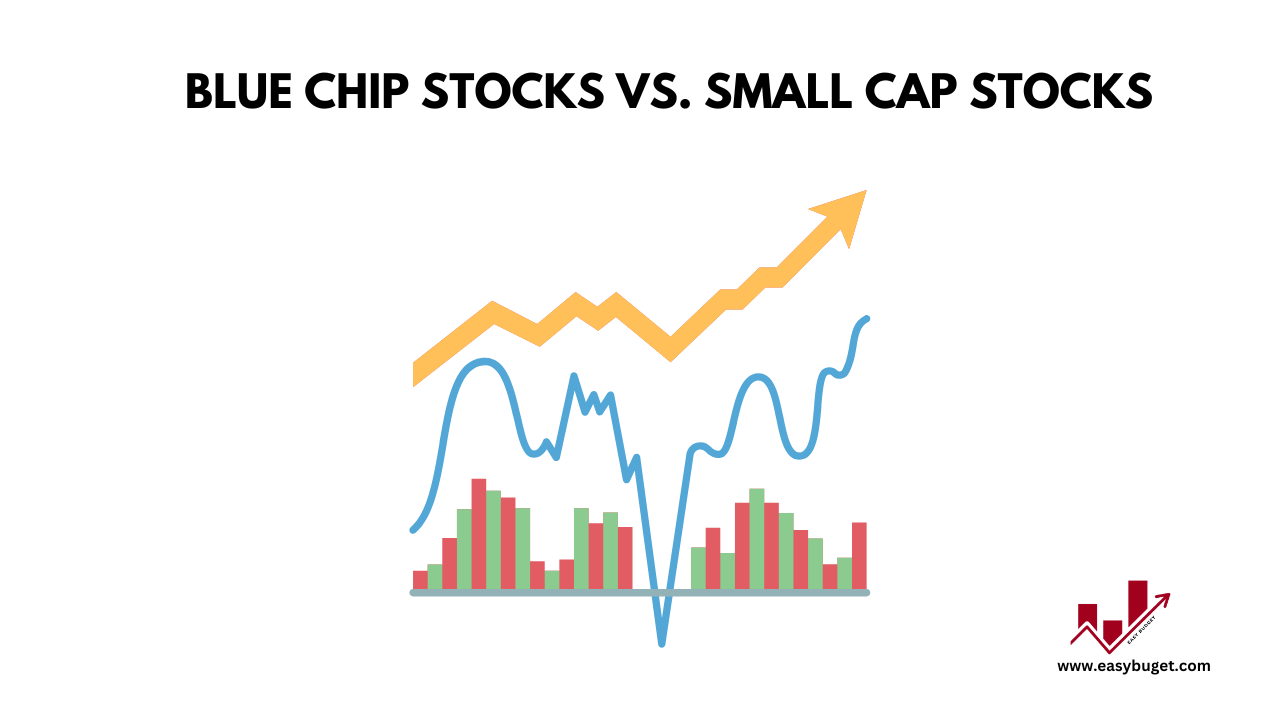Introduction
When it comes to investing, choosing the right stocks can feel like picking between a reliable old car and a flashy new sports car. Do you go for the steady, proven performance of blue chip stocks or the high-risk, high-reward potential of small cap stocks? Understanding the differences can help you build a balanced portfolio that suits your risk tolerance and financial goals.
In this guide, we’ll break down the risks and rewards of blue chip stocks vs small cap stocks so you can make an informed decision about where to invest your money.

What are Blue chip stocks?
Blue chip stocks belong to large, well-established companies with a long history of financial stability and steady growth. Think of household names like Apple, Microsoft, Coca-Cola and Johnson & Johnson—companies that have stood the test of time.
Key characteristics of Blue chip stocks:
✅ Large market capitalization (typically over $10 billion)
✅ Strong financials and consistent revenue growth
✅ Often pay dividends, making them attractive for passive income
✅ Lower volatility compared to smaller companies
✅ Considered a “safe” investment during market downturns
Blue chips are the backbone of many investment portfolios because they offer reliable growth with less risk. However, their size and stability often mean slower growth compared to smaller, more agile companies.
What are Small cap stocks?
Small cap stocks belong to companies with a smaller market capitalization, typically ranging between $300 million and $2 billion. These stocks are usually less established, high-growth companies that can skyrocket in value—but also carry higher risk.
Key characteristics of Small cap stocks:
✅ High growth potential—small companies can become the next big thing
✅ More affordable entry prices for investors
✅ Often overlooked by big institutions, allowing for undervalued opportunities
✅ More volatile—prices can swing dramatically
✅ Higher risk of bankruptcy or failure
Small caps can deliver massive returns if you invest in the right company at the right time. However, they also come with a greater chance of failure, making them a riskier bet for conservative investors.
Risk comparison: Blue chip stocks vs. Small cap stocks
Risk factors of Blue chip stocks:
🔹 Market fluctuations: While generally stable, even blue chips are affected by recessions and market downturns.
🔹 Slower growth: These companies are already well-established, meaning their stock price doesn’t increase as quickly as small cap stocks.
🔹 Overvaluation: Because they’re widely recognized, blue chip stocks can sometimes be overpriced, leading to lower future returns.
Risk factors of Small cap stocks:
🔹 High volatility: Small caps can experience extreme price swings, making them riskier in the short term.
🔹 Liquidity issues: These stocks often have lower trading volumes, making it harder to buy or sell shares quickly.
🔹 Higher failure rate: Many small companies don’t survive long-term, increasing the chance of losing money.
| Risk Factor | Blue chip stocks | Small cap stocks |
|---|---|---|
| Market fluctuations | Affected but generally stable | Highly volatile, frequent swings |
| Growth potential | Slower, steady growth | High growth potential but uncertain |
| Liquidity | Highly liquid, easy to trade | Lower trading volumes, harder to buy/sell |
| Failure risk | Low—established companies | High—many small caps don’t survive long-term |
| Overvaluation | Sometimes overpriced due to popularity | Often undervalued, but riskier |
Reward comparison: Blue chip stocks vs. Small cap stocks
Potential returns from Blue chip stocks:
✅ Consistent Growth: Blue chip stocks typically offer steady, long-term appreciation.
✅ Dividend Income: Many blue chips pay dividends, making them ideal for passive income. ✅ Less Stress: Lower volatility means fewer wild price swings, making them great for long-term investors.
Potential returns from Small cap stocks:
✅ Explosive growth: Small caps have the potential to double or triple in value quickly.
✅ Undervalued gems: Since institutional investors often overlook small caps, savvy investors can find hidden opportunities.
✅ Outperforms in bull markets: Historically, small caps tend to outperform blue chips during strong economic growth periods.
| Reward Factor | Blue chip stocks | Small cap stocks |
| Potential Returns | Moderate, steady long-term growth | High growth potential with possible rapid gains |
| Dividend income | Often pay reliable dividends | Rarely pay dividends, focusing on reinvestment |
| Stability | More stable, less risk of collapse | Higher risk, but opportunities for major upside |
| Institutional investment | Attracts major investors, adding security | Often overlooked, allowing for hidden opportunities |
| Performance in bull markets | Consistent but slower | Often outperforms blue chips in high-growth periods |
Which type of stock is right for you?
The choice between blue chip stocks and small cap stocks depends on your risk tolerance, financial goals and investment strategy.
💰 For conservative investors: Blue chip stocks provide stability, steady returns and dividend income. They’re a great choice if you prefer lower risk and long-term security.
📈 For aggressive investors: Small cap stocks offer higher risk but also higher potential rewards. If you’re comfortable with volatility and willing to take on more risk, small caps might be a great fit.
⚖️ For a balanced portfolio: A mix of both blue chip and small cap stocks can provide growth and stability. This approach allows you to enjoy the steady returns of blue chips while capitalizing on the high-growth potential of small caps.
Conclusion: Finding the right balance
Investing in Blue chip stocks and Small cap stocks is all about finding the right balance between risk and reward. Blue chips provide stability and consistent returns, while small caps offer higher growth potential but with more volatility.
The key is to align your stock choices with your risk tolerance, financial goals and investment horizon. Whether you prefer the reliability of blue chips or the thrill of small caps, diversification is your best strategy for long-term success.
So, what’s your investing style? Are you a blue chip believer or a small cap risk-taker? Let us know in the comments!
Please subscribe Easy Budget to stay updated about our latest blogs!

